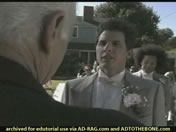Since all the pros are weighing in on it, let me say that Laura Shin’s umbrella review in Slate is wack. What purports to be a The New York Review of Umbrellas’s ignores some key aspects of New York City’s indigenous umbrella culture, and in ways that make me think it’s unconsciously geared to visitors, not residents, of the city.
This daytripper’s bias manifests itself in the criteria: saying smaller=better makes no more sense for umbrellas than bigger=better does for SUV’s. Unless you’re planning on carrying it folded up much of the time because, like the folks you see uptown with Century 21 bags, you don’t have an apartment or an office to stash stuff in.
Also, even in these Friends-friendly days, “plays well with others” is not a trait held in high esteem on New York City streets, especially not for umbrellas. For a lot of highly self-interested New Yorkers, bigger is better, even if it’s not, and getting your eye poked out is your problem, mac. [Note to Malcolm Gladwell: got another SUV story for you.]
Sure, there’s the Chinatown umbrella, but Manhattan’s other indigenous species–the Doorman Umbrella–is completely ignored. Maybe the writer lives in a walkup. These black giants are the Lincoln Town Car of umbrellas, more than you really need to do the job, and better if you have someone else doing it for you.
Lately there’s been a proliferation of Patented Umbrellas, which have those collapsible drinking cup-like sheaths on the tip. This is wrong. Convenient, surely, but wrong.
The Hotel Umbrella is an increasingly rare breed. These usually logo’ed Doormen Umbrellas are briefly loaned to guests at better hotels. [They’re getting rarer because some new better hotels now prefer to sell their guests an umbrella.] Someone once took my large black umbrella from the bucket at a shop, and left me with a nearly identical model courtesy of The Carlyle Hotel. Thanks.
The Firm Umbrella, the Golf Umbrella, and the Firm Golf Umbrella are usually seen in midtown, and truth be told, they’re probably being carried by some banker who moved to Rye when his second kid was born. In addition to being selfishly large for the street, these usually have the added benefit of being free (or at least it felt that way when you signed for it at the pro shop).
I recently lost my favorite umbrella, which had served me well for over six years. At the height of Niketown-hatin’ 1998, and figuring that they’d probably invest a lot in the R&D, I bought a big black Nike Golf umbrella. Yes, it had swooshes on it, but it was a small price to pay; the thing was light, strong, huge, and it never once blew out on me.
When someone stole it from a pizza restaurant a few months ago, I tried to replace it, but they sure don’t make’em like they used to. I ventured back into Niketown (what a dump), nothin’. The $15 model at the outlet you pass on 95 in Maryland was engineered to protect Nike’s margins, not my (or anyone else’s) head.
I know return you to your regularly scheduled programming.
Un-brellas [slate, via kottke and TMN]


 Never the innovator, apparently, NEC commissioned a series of sponsored short films which debuted last fall. The theme(s)? “Ubiquitous” and
Never the innovator, apparently, NEC commissioned a series of sponsored short films which debuted last fall. The theme(s)? “Ubiquitous” and  So the Walker Art Center reopened last week in Minneapolis, and the reviews I’ve seen are great.
So the Walker Art Center reopened last week in Minneapolis, and the reviews I’ve seen are great. For an exhibition in Dublin, Dutch artist Aleksandra Mir interviews Jim Fitzpatrick, the Irish artist who created the stencil-like poster of Che Guevara. It’s a fascinating story of copyright, revolution, and appropriation, told by someone who’s been largely invisible, even though he made one of the most widely known–and widely copied–images of the last 50 years.
For an exhibition in Dublin, Dutch artist Aleksandra Mir interviews Jim Fitzpatrick, the Irish artist who created the stencil-like poster of Che Guevara. It’s a fascinating story of copyright, revolution, and appropriation, told by someone who’s been largely invisible, even though he made one of the most widely known–and widely copied–images of the last 50 years.